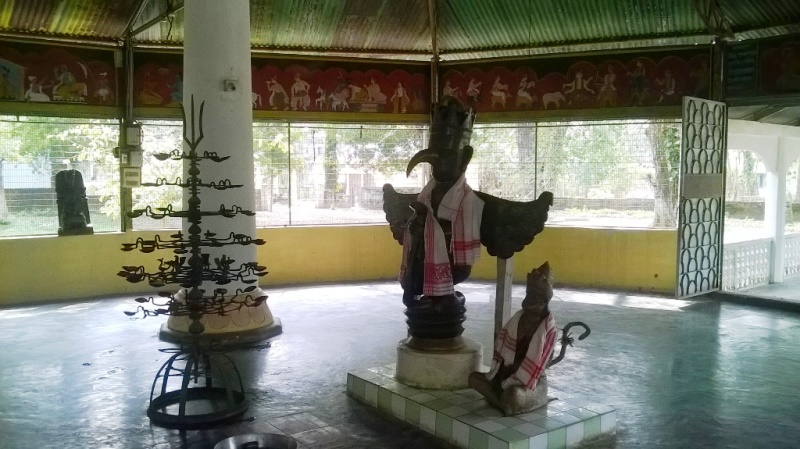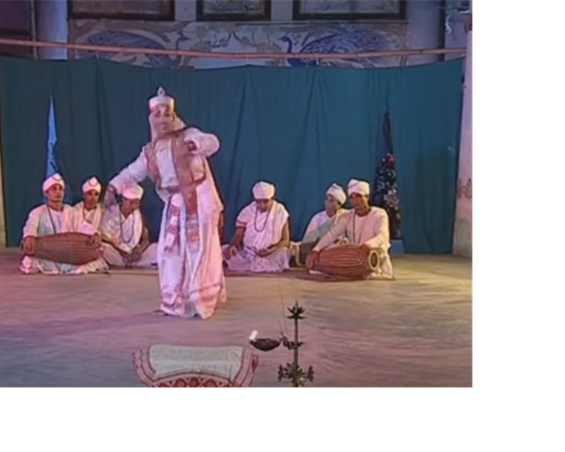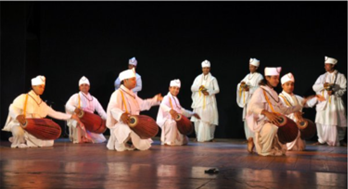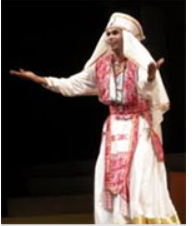Author: Seema K S, Bengaluru
Published as a part of Śāstra Raṅga-2023 Internship ; offered by NoopuraBhramari- IKS Centre. Article series No – 19
Aṅkiā[1] Nāṭa literally means one-act play; also known by the name Aṅkia Bhāona is a traditional theatre form of Assam. Saint scholar Śrīmanta Śaṅkaradeva is credited with the formation of this theatre form, he also established the Sattra-s[2] (Vaiśnava monasteries) for religious assemblies to popularize this art form. Sattra-s played an important role in preserving and promoting this theatre form by providing a platform for artistic expression, ritualistic dance drama to the presiding deity; right from the fifteenth-sixteenth century to this day.
Structure of Sattra:
In the complex of Sattra is the Nāmghara (prayer hall), Maṇikūṭa (garbha gṛha of the presiding deity) and the Hātis (where the priests and their families live). Nāmghara is the space where the training and the performance of the drama takes place; also known by the name Bhāona ghar (which facilitates artistic expressions). The structure of Nāmghara is canonical from the outside just like a cave as Bharata says, śailaguhākāro dvibhūmirnāṭyamaṇḍapaḥ[3] in the Prekśāgṛhalakṣaṅaṁ of Nāṭyaśāstra.
Underside of the roof of the Nāmghar is painted with scenes from Purāṇa-s and Ithihāsa-s.

Interior of Garmur Sattra, Majuli [4]
Performance:
The musicians enter the performance area with a white curtain held in the front and with lamps held using bamboo stick by two people. On entering the stage, the musicians (vocal, percussion, cymbal, harmonium player and flutist) taking their respective seats is Pratyahāra[5] and Avatarana[6] of Pūrvaraṅga vidhi of Nāṭyaśāstra; the former is arrangement of musical instruments and the latter is musicians taking their respective seats. There are delineations in the positioning of the musicians. In a Sattra, the musicians are seated in the backend-centre of the performance area; in front of the Nepathya screen and the play happens in front of them. This is similar to the position of the drums on the stage mentioned in Nāṭyaśāstra[7]. A pictorial representation of the same is given below:

Performance in progress [8]

Dhemali in progress.[11]

Sūtradhāra[16]
Āhāryābhianaya of Aṅkiā Nāṭa uses props like bow-arrow for Rāma, sword for Rāvaṇa. Sudarśana cakra for Kṛṣṇa. Flowers are also used for the drama Pārijāta haraṇa. Villains and special characters like Garuḍa, Vāli, Mohini etc use masks (Mukha) made of bamboo, clay and hay. Masks vary from small to life-size and enhances the visual aspects of the drama. Mask-making is very different from what is mentioned in Nāṭyaśāstra; nevertheless, use of weapons (using props) and masks are encouraged in Nāṭyaśāstra.
In the author’s visit to the mask making Sattra in Majuli – Assam, she was fortunate to have met Sri Hem Chandra Goswami[18] and his younger brother. She learnt that the masks developed off-late have movable jaws to facilitate better breathing and dialogue delivery of the actors.
To sum up, traces of Naṭyaśāstra are seen in this theatre form which was developed during the Neo-Vaisnavism period to promote Viśṇu Bhakti among commoners by Śaṅkaradeva and his successors. Aṅkiā Nāṭa and Sattra-s, have been the sources for the origin of desi dance form Sattriya of Assam. Thus, one can understand and witness even today, the extent of practical application of Naṭyaśāstra by the remote north-east artists belonging to tribal communities of India without having read about any of the śastrā-s!
Endnotes
[1] Same as Aṅka of Saṁkṛta
[2] similar to the Kūtambalaṁ of Kerala
[3] Śloka 80, Chapter 2
[4] https://majuliriverisland.wordpress.com/garmur-satra-majuli-island/
[5] Śloka 17, Chapter 5
[6] Śloka 17, Chapter 5
[7] Śloka 2, Chapter 11
[8] https://www.youtube.com/watch?v=fclytPcNTCM
[9] Equivalent to Pūrvaraṅga/ preliminaries of a play
[10] Citra Pūrvaraṅga involves continuous bodily movements (Aṅgahāra-s)
[11]https://www.google.com/imgres
[12] Śloka 23, Chapter 5
[13] Śloka 24, Chapter 5
[14] Śloka 29, Chapter 5
[15] Śloka 135, Chapter 5
[16] https://www.indianetzone.com/18/the_ankiya_nat_assam.htm
[17] Śloka 2-3, chapter 12
[18] Sangeet Natak Academy winner for mask making
References:
April 11th, 2023 at 11:58 am
Excellent work Seema KS, you are the best
All the best for all your future endeavours.